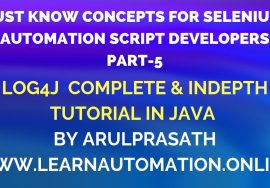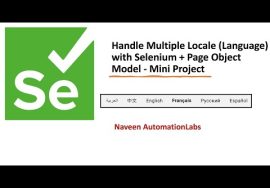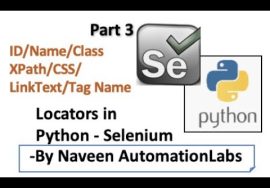Data Analysis with Python – Full Course for Beginners (Numpy, Pandas, Matplotlib, Seaborn)
Learn Data Analysis with Python in this comprehensive tutorial for beginners, with exercises included!
NOTE: Check description for updated Notebook links.
Data Analysis has been around for a long time, but up until a few years ago, it was practiced using closed, expensive and limited tools like Excel or Tableau. Python, SQL and other open libraries have changed Data Analysis forever.
In this tutorial you'll learn the whole process of Data Analysis: reading data from multiple sources (CSVs, SQL, Excel, etc), processing them using NumPy and Pandas, visualize them using Matplotlib and Seaborn and clean and process it to create reports.
Additionally, we've included a thorough Jupyter Notebook tutorial, and a quick Python reference to refresh your programming skills.
? Course created by Santiago Basulto from RMOTR
? Check out all Data Science courses from RMOTR:
⚠️ Note: Instead of loading the notebooks on notebooks.ai, you should use Google Colab instead. Here are instructions on loading a notebook directly from GitHub into Google Colab:
⭐️ Course Contents ⭐️
⌨️ Part 1: Introduction
What is Data Analysis, why Python?, what other options are there? what's the cycle of a Data Analysis project? What's the difference between Data Analysis and Data Science?
? Slides for this section:
⌨️ Part 2: Real Life Example of a Python/Pandas Data Analysis project (00:11:11)
A demonstration of a real life data analysis project using Python, Pandas, SQL and Seaborn. Don't worry, we'll dig deeper in the following sections
? Notebooks:
⌨️ Part 3: Jupyter Notebooks Tutorial (00:30:50)
A step by step tutorial to learn how to use Juptyer Notebooks
? Twitter Cheat Sheet:
? Notebooks:
⌨️ Part 4: Intro to NumPy (01:04:58)
Learn why NumPy was such an important library for the data-processing world in Python. Learn about low level details of computations and memory storage, and why tools like Excel will always be limited when processing large volumes of data.
? Notebooks:
⌨️ Part 5: Intro to Pandas (01:57:08)
Pandas is arguably the most important library for Data Processing in the Python world. Learn how it works and how its main data structure, the Data Frame, compares to other tools like spreadsheets or DFs used for Big Data
? Notebooks:
⌨️ Part 6: Data Cleaning (02:47:18)
Learn the different types of issues that we'll face with our data: null values, invalid values, statistical outliers, etc, and how to clean them.
? Notebooks:
⌨️ Part 7: Reading Data from other sources (03:25:15)
? Notebooks:
⌨️ Part 8: Python Recap (03:55:19)
If your Python or coding skills are rusty, check out this section for a quick recap of Python main features and control flow structures.
? Notebooks:
—
Learn to code for free and get a developer job:
Read hundreds of articles on programming:
And subscribe for new videos on technology every day:











⚠️ Note: Instead of loading the notebooks on notebooks.ai, you should use Google Colab instead. Here are instructions on loading a notebook directly from GitHub into Google Colab: https://colab.research.google.com/github/googlecolab/colabtools/blob/master/notebooks/colab-github-demo.ipynb#scrollTo=K-NVg7RjyeTk
The code links in the description have been updated to the content stored on GitHub.
hallo, i tried learning file about bike sales, in jupyter there is code “!head data/sales_data.csv” what is it? and in my jupyter after i run the cell it print out “‘head’ is not recognized as an internal or external command,
operable program or batch file.” what is this !head? and how to fix the error?
I thought it would have been explained more easily for Colab novices. I manually downloaded the csv from github and then loaded then created the ‘data’ folder in the Colab storage path. Pasted the csv file in there to mimic what was shown in the Video
@Mohamed Sajjad if you look at the “description box” under the video, each section has links that lead you to github. From github, you can access the exercises and data used in the videos. Hope that’s helpful to all the confused people in the comments with this particular question 🙂
@Alex Roberts Thanks, helped a lot!
*My takeaways:*
*1. Table of Content* 1:45
*2. Introduction **2:52*
2.1 What is data analysis 2:52
2.2 Data analysis tools 4:38
2.3 Data analysis process 7:31
2.4 Data Analysis vs Data Science 8:56
2.5 Python and PyData Ecosystem 9:28
2.6 Python data analysis vs Excel 9:46
*3. Real example data analysis with Python: getting a sense of what you can learn from this course **11:00*
*4. How to use Jupyter Notebooks **30:50*
*5. Intro to NumPy **1:04:58*
5.1 Low-level basis: binary numbers, memory footprint 1:09:32
5.2 Python is not memory efficient to store numbers since it wraps everything into objects. Whereas in NumPy, we can select the number of bits to represent numbers 1:22:50
5.3 NumPy can compute arrays faster than Python 1:24:58
5.4 NumPy tutorial: NumPy arrays, matrices 1:29:47
5.5 Memory footprint and performance: Python vs NumPy 1:53:14
*6. Intro to Pandas: getting, processing and visualizing data **1:56:58*
6.1 Pandas data structure: Series 1:58:41
6.2 We can change the index of Pandas series and this is fundamentally different from NumPy arrays 2:02:55
6.3 The upper limit of slicing in Pandas series is included, whereas, in NumPy, the limit is excluded 2:07:55
6.4 Pandas data structure: DataFrames 2:14:36
6.5 Most operations in Pandas are immutable 2:29:10
6.7 Reading external data 2:36:47
6.8 Pandas plotting 2:44:41
*7. Data cleaning **2:47:18*
7.1 Handling miss data 2:51:40
7.2 Cleaning invalidate values 3:03:17
7.3 Handling duplicated data 3:06:09
7.4 Handling text data 3:11:05
7.5 Data visualization 3:13:41
7.6 Matplotlib global API 3:14:25
7.7 Matplotlib OOP API 3:18:27
*8. Working with data from(/to) SQL, CSV, txt, API etc. **3:25:15*
8.1 Python methods for working with files 3:26:37
8.2 Python methods for working with CSV files 3:29:33
8.3 Pandas methods for working with CSV files 3:30:05
8.4 Python methods for working with SQL 3:36:17
8.5 Pandas methods for working with SQL 3:38:58
8.6 Pandas methods for working with HTML 3:43:09
8.7 Pandas methods for working with Excel files 3:49:56
*9. Python recap **3:55:18*
Many thx!
Lei Xun Thanks for sharing
As a data analyst in Maersk, I really appreciate this course in balancing between the technical foundations and actual executions! Most people only get to learn the codes without understanding the concepts, which are what separate workers from engineers!
how much do you earn asa data analyst
Hi it seems like you were able to successfully complete the course did u have any troubles in accessing the sales file?
Part 1: Introduction
Part 2: Real Life Example of a Python/Pandas Data Analysis project 00:11:11
Part 3: Jupyter Notebooks Tutorial (00:30:50)
Part 4: Intro to NumPy (01:04:58), (01:30:00)
Part 5: Intro to Pandas (01:57:08)
Part 6: Data Cleaning (02:47:18)
Part 7: Reading Data from other sources (03:25:15)
Part 8: Python Recap (03:55:19)
@Soafiavy Junior I am stuck over here ..next what to do… !
@Aryan Jaiswal bro after this what to do ? Please guide me !
Hero
did he cover matplotlib
what is purpose og jupyter and notebook ? didnt get it?
Oh, thank you so much brothers, I have been waiting for a course like this from you guys, your channel has been so much helpful for me to improve my coding skills. You guys deserve to receive an award for this incredible service. Thanks again brothers, keep it up. ?
Is that enough to study in data analysis?
You’re absolutely brilliant and generous for giving out this much information for all of us to learn, thank you!
This is the best channel ever.
No one does so clear, long and ad free videos….
My compliments ?????
one makes and he is CodeWithHarry, but he speaks Hindi language but he is too funny in his videos and has a God-Gifted explaining things talent and also makes such longer videos.
??????
Is that enough to study in data analysis?
@Sarvesh Gupta no dude
Been looking forward to this course since the beginning of the year. It could not have come at a better time. Thank you very much!
Steven Negishi exaclty
Amazing video, really really good, thank you Santiago for offering such a great free class online.
This is so great and I have not seen a session like this before and its so well explained. Great job !!
Impressive and helpful tutorial. Thanks for this amazing teaching.
Great contents. The speaker knows exactly what he’s talking about and has great deal of detail knowledge about python and various libraries. Thank you for sharing.
I’m just wondering if sharing the fundamentals and ground level details (numpy memory) could have been a separate course all together and this one could have just focused on data analysis, may be….
Very thorough video, does a great job of explaining intricate concepts in a simple way.
I have been watching your course for 2 weeks and I can say this is the best guide I have ever seen. Thank you guys
How you are doing the practicals? Can you help me out?
Thank you!
Congratulations, what quality of information you provide us, I have perfected my learning with the help of this channel
This tutorial is perfect. Thank you very much for making it!
1:45:43 Notably you _can_ multiply arrays of different dimensions so long as the array with more dimensions is made up of arrays of the same shape as the smaller array.
I just finished it and the content is just awesome. It gets easy the way trainer explains things here. Thanks a ton for this lovely content.
@Sagnik Mukherjee thank you dada??
@Sheldon Cooper ekdom start kora jabe. Ami jokhon start korechilam ami o python r basic e jantam. Chotpot start kore dao. Khub valo kore e bujhiyeche. Best of luck.
Accha course tar prerequisites ki ki? Ami c java valo kore jani.. python er ekdom basic gulo jani.. mane oi if else loop eisob gulo just. Python a Kono coding experience nei. Ei video ta start kora jbe?
hello, does this course have matplotlib, seaborn and all?
This course is awesome ! The explanations are very clear and the teaching way is very fine. Thank you so much for all the hard work you put in making this !
Wow excellent explanation and easy to understand. I love the presentation . Thank you ?